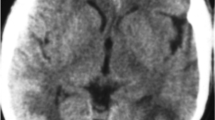Abstract
Introduction
In addition to diffuse brain oedema, diabetic ketoacidosis (DKA) can lead to ischaemic or haemorrhagic stroke, extrapontine myelinolysis, and sinovenous thrombosis. However, posterior reversible encephalopathy syndrome (PRES) and spinal cord oedema are rarely reported in patients with DKA.
Methods
We present a case of a 17-year-old-girl who developed headache, blurred vision, and paraplegia after her DKA was controlled. Sequential magnetic resonance (MR) scans of the brain and spinal cord were performed.
Results
Brain MR showed large patchy lesions in the bilateral white matter of the parieto-occipital lobes, which had high T2 signal intensity and low T1 signal intensity. MR scanning of the spinal cord showed longitudinal confluent central spinal cord T2 hyperintensity spanning seven thoracic spinal segments. With symptomatic treatment, the patient’s headache and vision disturbance subsided within 1 week. Subsequent MR scans demonstrated that the lesion in the spinal cord had decreased significantly in 10 days, and the large patchy lesions in the brain disappeared completely in 2 months. Her paraplegia improved gradually without obvious sequela 3 months later. The evolution of the disease and radiological findings supported the diagnosis of PRES with spinal cord involvement.
Conclusion
To the best of our knowledge, this is the first case report describing PRES with spinal cord involvement as a complication of DKA. PRES is a rare complication that should be considered along with other neurological complications of DKA when focal deficits appear.



Similar content being viewed by others
References
Acar NP, Arsava EM, Gocmen R, Dericioglu N, Topcuoglu MA (2013) Diabetic uremic syndrome studied with cerebral MR spectroscopy and CT perfusion. Metab Brain Dis 28(4):711–715. https://doi.org/10.1007/s11011-013-9427-x
Akın F, Kılıçaslan C, Solak ES, Uzun M, Aygün S, Arslan Ş (2014) Posterior reversible encephalopathy syndrome in children: report of three cases. Childs Nerv Syst 30(3):535–540. https://doi.org/10.1007/s00381-013-2342-y
Barrot A, Huisman TA, Poretti A (2016) Neuroimaging findings in acute pediatric diabetic ketoacidosis. Neuroradiol J 29(5):317–322. https://doi.org/10.1177/1971400916665389
Christodoulidou M, Selmi F (2012) Severe diabetic ketoacidosis leading to cardiac failure, pulmonary oedema and spinal cord oedema resulting in tetraplegia. BMJ Case Rep 2012(1):bcr2012006769. https://doi.org/10.1136/bcr-2012-006769
de Havenon A, Joos Z, Longenecker L, Shah L, Ansari S, Digre K (2014) Posterior reversible encephalopathy syndrome with spinal cord involvement. Neurology 83(22):2002–2006. https://doi.org/10.1212/WNL.0000000000001026
Dixon AN, Jude EB, Banerjee AK, Bain SC (2006) Simultaneous pulmonary and cerebral oedema, and multiple CNS infarctions as complications of diabetic ketoacidosis: a case report. Diabet Med 23(5):571–573. https://doi.org/10.1111/j.1464-5491.2006.01822.x
Fugate JE, Rabinstein AA (2015) Posterior reversible encephalopathy syndrome: clinical and radiological manifestations, pathophysiology, and outstanding questions. Lancet Neurol 14(9):914–925. https://doi.org/10.1016/S1474-4422(15)00111-8
Hoffman WH, Burek CL, Waller JL, Fisher LE, Khichi M, Mellick LB (2003) Cytokine response to diabetic ketoacidosis and its treatment. Clin Immunol 108(3):175–181. https://doi.org/10.1016/S1521-6616(03)00144-X
Jones R, Redler K, Witherick J, Fuller G, Mahajan T, Wakerley BR (2017) Posterior reversible encephalopathy syndrome complicating diabetic ketoacidosis; an important treatable complication. Pediatr Diabetes 18(2):159–162. https://doi.org/10.1111/pedi.12362
Mozzillo E, D'Amico A, Fattorusso V, Carotenuto B, Buono P, de Nitto E, Falco M, Franzese A (2015) Cerebral accidents in pediatric diabetic ketoacidosis: different complications and different evolutions. Horm Res Paediatr 84(2):139–144. https://doi.org/10.1159/000382016
Nett ST, Noble JA, Levin DL et al (2014) Biomarkers and genetics of brain injury risk in diabetic ketoacidosis: a pilot study. J Pediatr Intensive Care 3
Oller-Navarro JL, Rivera-Reyes L, Rodriguez-Rivera AA (1979) Juvenile diabetic myelopathy. A 14-year-old girl with juvenile diabetes mellitus complicated by acute transverse myelopathy. Clin Pediatr (Phila) 18(1):60–61. https://doi.org/10.1177/000992287901800109
Roberts JS, Vavilala MS, Schenkman KA, Shaw D, Martin LD, Lam AM (2006) Cerebral hyperemia and impaired cerebral autoregulation associated with diabetic ketoacidosis in critically ill children. Crit Care Med 34(8):2217–2223. https://doi.org/10.1097/01.CCM.0000227182.51591.21
Roe TF, Crawford TO, Huff KR, Costin G, Kaufman FR, Nelson MD (1996) Brain infarction in children with diabetic ketoacidosis. J Diabetes Complicat 10(2):100–108. https://doi.org/10.1016/1056-8727(94)00058-1
Funding
A grant of the Natural Science Foundation of LiaoNing Province (No. 201602883) supports the paper’s preparation and publication.
Author information
Authors and Affiliations
Contributions
All authors participated in the design of the study, collection, and analysis of the data. J.N. and D.Z. wrote the manuscript. All authors read and approved the final manuscript.
Corresponding author
Ethics declarations
Conflicts of interest
All authors report no conflict of interest to disclose.
Informed consent
Informed consent was obtained from all individual participants included in the study.
Rights and permissions
About this article
Cite this article
Nao, J., Zhang, H., Wu, S. et al. Posterior reversible encephalopathy syndrome with spinal cord involvement (PRES-SCI) as a rare complication of severe diabetic ketoacidosis: a case report and review of the literature. Childs Nerv Syst 34, 701–705 (2018). https://doi.org/10.1007/s00381-018-3724-y
Received:
Accepted:
Published:
Issue Date:
DOI: https://doi.org/10.1007/s00381-018-3724-y




